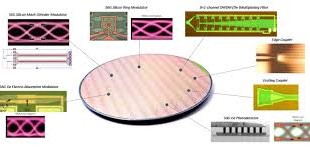Muons are subatomic particles that behave a lot like electrons but are around 200 times heavier. As the US Department of Energy explains, “Muons created in the atmosphere constantly hit every inch of the Earth’s surface and pass through almost any substance.”
Many scientists have noted that measuring the passage of muons offers the chance to measure the interior of whatever object the particles pass through during the 2.2 microseconds or so they exist before decaying into an electron and neutrinos. Muon radiography works by tracking the charged subatomic particles muons, generated when cosmic rays interact with Earth’s atmosphere. These muons travel down at high speeds through the atmosphere and can pass through solid objects.
Muography is an imaging technique based on the measurement of absorption profiles for muons as they pass through rocks and earth. As they pass through the space, nuclear emulsion plates are used as detectors to ‘catch’ the particles and develop an image of where the muons passed through, and where they were absorbed or deflected. This same method has been used on pyramids in Egypt, using the constant rain of atmospheric muons that bathes the Earth every day, and techniques that aren’t vastly different to those used with gamma rays, X-rays, neutrons, protons, and electrons in imaging applications.
This technology has developed rapidly over the last 15 years, and it is currently branching out into many different applications and moving from academic research to commercial application. The technological developments in the detection of elementary particles have opened the way to its application in various fields, such as archaeology, studies of geological structures, civil engineering and security issues.
The Defense Department and other federal agencies have sought advanced sources that generate gamma rays, X-rays, neutrons, protons, and electrons to enable a variety of scientific, commercial, and defense applications – from medical diagnostics, to scans of cargo containers for dangerous materials, to non-destructive testing of aircraft and their parts to see internal defects. But none of these sources can image through concrete walls several meters thick, map the core of a volcano from the outside, or peer deep underground to locate chambers and tunnels. For such imaging capabilities, a more powerful particle is needed.
DARPA launched Muons for Science & Security program (MuS2 – pronounced Mew-S-2) program in July 2022 aiming to create a compact source of deeply penetrating subatomic particles known as muons. Muons are similar to electrons but about 200 times heavier. At high energy, muons can travel easily through dozens to hundreds of meters of water, solid rock, or soil. Producing muons, however, is a challenge, because it requires a very high-energy, giga-electronvolt (GeV) particle source. Currently, two primary sources for muons exist. Cosmic ray interactions in the upper atmosphere naturally generate muons as they descend to Earth in created particle showers.
Harnessing these muons for imaging is tedious and not very practical. Cosmic muons have played a role in special projects, such as when scientists used them to image interior chambers of the great pyramids in Egypt. Given the small number of muons that reach the Earth’s surface and the divergent paths they travel through the atmosphere, it can take days to months to capture enough muon data to produce meaningful results. Muons can also be generated terrestrial.
But making muons requires such high-energy particles that production is limited to large physics research facilities such as the United States’ Fermilab national particle accelerator in Illinois and the European CERN accelerator in Switzerland. Fermilab watches muons at work in a facility that incorporates “a 50-foot-diameter superconducting magnetic storage ring, which sits in its detector hall amidst electronics racks, the muon beamline, and other equipment” – and operates at negative 450 degrees Fahrenheit (-267.8°C), so you’ll need the thick mittens.
“Our goal is to develop a new, terrestrial muon source that doesn’t require large accelerators and allows us to create directional beams of muons at relevant energies, from 10s to 100s of GeVs – to either image or characterize materials,” said Mark Wrobel, MuS2 program manager in DARPA’s Defense Sciences Office. “Enabling this program is high-peak-power laser technology that has been steadily advancing and can potentially create the conditions for muon production in a compact form factor. MuS2 will lay the ground work needed to examine the feasibility of developing compact and transportable muon sources.”
MuS2 aims to employ what’s called laser plasma acceleration (LPA) to initially create 10 GeV particles in the space of tens of centimeters compared to hundreds of meters needed for state-of-the art linear accelerators. Ultimately, MuS2 seeks to develop scalable and practical processes to produce conditions that can create muons exceeding 100 GeV through innovations in LPA, target design, and compact laser driver technology.
Muons are sensitive to density variation as they penetrate materials, which makes them particularly advantageous for locating voids in solid structures. If MuS2 and any follow-on efforts are successful, whole buildings could be scanned from the outside to characterize internal structures and detect the presence of threat materials such as special nuclear materials. Other potential applications include rapidly mapping the location of underground tunnels and chambers hundreds of meters below the Earth’s surface.
MuS2 is a four-year program divided into two phases. During the 24-month first phase, teams will conduct initial modeling and scaling studies and use experiments to validate models as well as attempt to produce 10 GeV muons. In the second 24-month phase, teams will aim to develop scalable accelerator designs for 100 GeV or greater and produce relevant numbers of muons for practical applications.
Given the strong focus on fundamental research, high-energy physics, and defense applications, MuS2 seeks integrated teams that can holistically investigate practical muon sources. Teams will require expertise in the following areas:
- Experimentation: Petawatt-level laser facilities, LPA regimes, and muon target design
- Simulation: High-performance computing, particle-in-cell, Monte Carlo, and multiphysics modeling
- Laser driver and system studies: Exploration of efficient, compact, and high-repetition rate laser technologies and design studies leading to systems with transportable form factors
“To address these diverse research areas, we anticipate building integrated teams composed of academia, national laboratories, and defense industries,” Wrobel said.
References and Resources also include:
https://www.theregister.com/2022/07/25/darpa_portable_muon_generator/
 International Defense Security & Technology Your trusted Source for News, Research and Analysis
International Defense Security & Technology Your trusted Source for News, Research and Analysis

